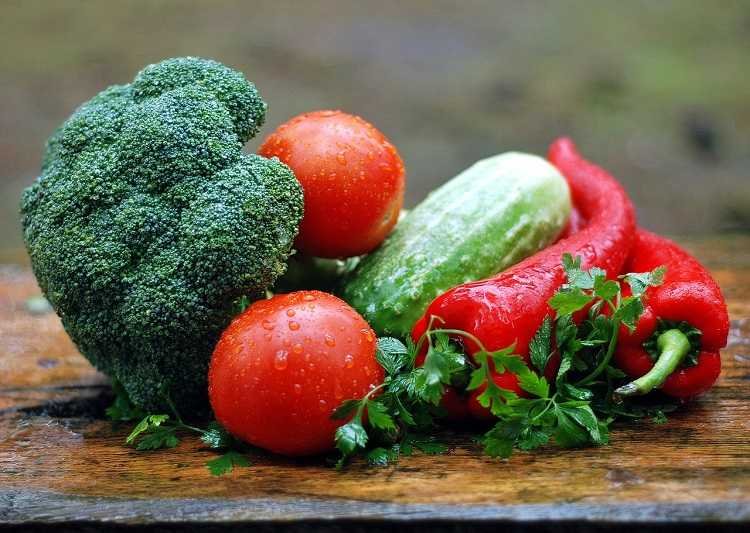22 Actionable Tips To Get Your Children To Eat Vegetables

Are you tired of battling with your kids to eat their vegetables? It can feel like an uphill battle, but fear not! We have 20 actionable tips that will turn your little ones into veggie-loving champions.
From introducing vegetables in a fun and exciting way to involving them in meal planning and preparation, we’ve got you covered.
Get ready to celebrate vegetable success stories as you discover the secrets to getting your children to gobble up those greens.
Let’s dive in and make healthy eating a breeze!
Actionable Tips To Get Your Children To Eat Vegetables
1. Introducing Vegetables in a Fun and Exciting Way
Introducing vegetables in a fun and exciting way can make your children more willing to try them. One effective method is to involve your kids in the process of choosing and preparing the vegetables.

Take them to the grocery store or farmer’s market and let them pick out their favorite veggies. Encourage creativity by allowing them to help wash, chop, or arrange the vegetables on their plates.
Another idea is to turn eating veggies into a game. Create a chart where they can earn points for trying new vegetables or finishing their plates. Offer small rewards, such as stickers or extra playtime, when they reach certain milestones.
Finally, make sure you lead by example; if your children see you enjoying vegetables, they are more likely to follow suit.
By incorporating these fun strategies into mealtime, you can increase your child’s willingness to eat vegetables while also fostering healthy habits for life.
2. Getting Creative with Veggie Shapes and Colors
Try creating fun shapes and using vibrant colors to make vegetables more appealing to your little ones. Studies have shown that children are more likely to eat vegetables when they are presented in a visually enticing way.
One simple trick is to use cookie cutters to shape vegetables into fun designs like stars or animals. You can also try arranging different colored veggies in a rainbow pattern on their plate.
Another idea is to get creative with vegetable skewers, combining colorful veggies like cherry tomatoes, bell peppers, and zucchini.
By making vegetables look exciting and visually appealing, you can spark your child’s interest and curiosity, making them more likely to give them a try.
3. Sneaking Veggies into Favorite Dishes
One way to incorporate more vegetables into your family’s diet is by sneaking them into their favorite dishes. By doing this, you can ensure that your children are getting the nutrients they need while still enjoying their meals.
There are several ways to go about sneaking veggies into dishes without your children even realizing it. For example, you can puree vegetables and add them to sauces, soups, or casseroles. This not only adds an extra serving of veggies but also enhances the flavor and texture of the dish.
Another option is to finely chop vegetables and mix them in with ground meat for burgers, meatballs, or tacos. The vegetables blend in seamlessly and add moisture and nutritional value to these popular dishes.
Sneaking veggies into favorite dishes is a great strategy for increasing vegetable consumption without any fuss or resistance from picky eaters.
4. Involving Kids in Meal Planning and Preparation

Get your kids excited about mealtime by involving them in the planning and preparation of their favorite dishes. This not only encourages a positive attitude towards vegetables, but also helps develop important life skills.
- Again, let your children pick out vegetables at the grocery store or farmer’s market. Giving them a choice empowers them and increases their interest in trying new veggies.
- Have a weekly family meeting to plan meals together. Ask for their input on what vegetables they would like to incorporate into each meal.
- Encourage your kids to help with age-appropriate tasks in the kitchen, such as washing, chopping, or stirring vegetables. This gives them a sense of ownership and pride in the final dish.
By involving your children in meal planning and preparation, you can create an enjoyable experience that promotes healthy eating habits and a love for vegetables.
5. Growing a Vegetable Garden Together

Involve your kids in growing a vegetable garden together to foster their love for fresh produce and teach them valuable gardening skills.
Research has shown that involving children in gardening activities can increase their willingness to try new vegetables and develop a positive attitude towards healthy eating habits. [1]
Not only does it provide an opportunity for quality family time, but it also allows children to witness the entire process of food production, from planting seeds to harvesting ripe vegetables.
To get started, designate an area in your yard or even use pots if you have limited space. Let your kids choose which vegetables they would like to grow, making sure to include a variety of colors and flavors.
Teach them how to prepare the soil, plant the seeds or seedlings, and care for the plants by watering and weeding regularly. Encourage them to observe the growth progress and celebrate each milestone together.
As the vegetables start maturing, involve your kids in harvesting and preparing meals using their garden-fresh produce.
This will give them a sense of accomplishment and pride in what they have grown. Additionally, involve them in decision-making when planning future gardens so that they feel ownership over the process.
6. Setting a Good Example by Eating Vegetables Yourself
Show your kids how delicious and nutritious vegetables can be by enjoying them yourself as part of your everyday meals. By setting a good example, you can inspire your children to develop healthy eating habits.
Remember, leading by example is one of the most effective ways to encourage your kids to eat more vegetables and establish lifelong healthy habits.
7. Exploring Different Cooking Methods for Vegetables
Now that you’ve set a good example by eating vegetables yourself, it’s time to explore different cooking methods that can make veggies more appealing to your children.
By using various cooking techniques, you can enhance the taste and texture of vegetables, making them more enjoyable for your little ones.
One method to try is roasting. Roasting vegetables brings out their natural sweetness and adds a delicious caramelized flavor. Simply toss them in olive oil, sprinkle with some salt and pepper, and roast in the oven until they are tender and golden brown.
Another option is stir-frying. This quick cooking method retains the vibrant colors and crispness of vegetables while adding a savory flavor. Use a hot pan or wok with a small amount of oil, toss in your favorite veggies along with some garlic or ginger for extra flavor, and cook until they are just tender.
By experimenting with different cooking techniques, you can find the ones that best suit your child’s taste buds and make eating vegetables an exciting experience for them!
8. Making Vegetable Smoothies and Juices

To make vegetable smoothies and juices more appealing, try adding a touch of sweetness with fruits like bananas or berries. This not only enhances the taste but also helps mask any bitterness from the vegetables.
Smoothies are a great way to incorporate a variety of vegetables into your child’s diet without them even realizing it.
Start by choosing a base such as almond milk or yogurt, then add in your favorite vegetables like spinach, kale, or carrots. You can also throw in some avocado for added creaminess and healthy fats.
Blend everything together until smooth and serve in fun cups or with colorful straws to make it visually appealing.
Juices can be made using a juicer or blender by extracting the liquid from the vegetables and fruits. Adding a squeeze of lemon can help balance out any strong flavors.
9. Trying New and Exotic Vegetables
If you’re looking to expand your child’s vegetable palate, trying new and exotic vegetables can be a fun and adventurous way to introduce them to different flavors. Here are five tips to help you in this exciting endeavor:
- Start with small portions: Begin by offering a small taste of the new vegetable alongside familiar dishes. This will allow your child to get accustomed to the flavor without feeling overwhelmed.
- Make it a family affair: Involve your child in the process of choosing and preparing the new vegetable. Take them grocery shopping with you or let them help wash and chop the vegetables at home. This involvement can create excitement and curiosity.
- Pair with favorite foods: Serve the new vegetable alongside your child’s favorite foods. For example, if they love pasta, mix some cooked broccoli into their spaghetti sauce.
- Be a role model: Show enthusiasm for trying new vegetables yourself. Children often imitate their parents’ behaviors, so if they see you enjoying something, they may be more willing to try it too.
By following these tips, you can make trying new and exotic vegetables an enjoyable experience for both you and your child while expanding their vegetable repertoire.
10. Offer a Variety of Vegetables at Every Meal

Make sure you include a variety of vegetables in every meal to provide your child with a well-rounded and nutritious diet.
Offering a wide range of vegetables not only exposes your child to different flavors, textures, and colors, but also ensures they receive essential nutrients for their growth and development.
When planning meals, think beyond the usual suspects like carrots and broccoli. Include options like bell peppers, spinach, sweet potatoes, or even Brussels sprouts. By introducing new vegetables regularly, you can expand your child’s palate and increase their acceptance of different foods.
To make it even more enticing for your child, try incorporating vegetables in creative ways. Add grated zucchini into muffins or pancakes, blend cauliflower into macaroni and cheese sauce, or make veggie-packed stir-fries or soups.
11. Using Dips and Sauces to Enhance the Flavor of Vegetables
Enhance the flavor of your child’s vegetables by using delicious dips and sauces. This simple trick can make a world of difference in getting your little ones to eat their veggies.
Here are five irresistible options to consider:
- Creamy ranch dip: The tanginess of ranch pairs perfectly with crunchy carrots or celery sticks.
- Hummus: This Middle Eastern dip adds a nutty and savory taste that complements a variety of vegetables like cucumber slices or bell pepper strips.
- Peanut sauce: A Thai-inspired sauce made with peanut butter, soy sauce, and lime juice can jazz up broccoli florets or sugar snap peas.
- Tomato salsa: The combination of tomatoes, onions, and spices adds a burst of flavor to steamed or roasted zucchini and squash.
- Yogurt-based tzatziki: Cucumber, garlic, and dill create a refreshing dip that goes well with cherry tomatoes or baby spinach leaves.
By offering these tasty accompaniments, you can encourage your children to enjoy their veggies while also introducing them to new flavors from around the world.
12. Encouraging Role Models to Promote Vegetable Consumption
Encourage your child to look up to positive role models who promote and enjoy eating vegetables. When children see their favorite celebrities, athletes, or even friends enjoying a variety of vegetables, they are more likely to follow suit.
Role models can include famous chefs like Jamie Oliver, who actively promotes the importance of healthy eating and incorporates vegetables in his recipes.
Additionally, involving your child in community programs or clubs that focus on nutrition and vegetable consumption can introduce them to peers who share similar interests and habits.
By surrounding your child with positive influences who embrace vegetables as an essential part of their diet, you are fostering a supportive environment that encourages them to try new foods and develop a lifelong love for vegetables.
13. Making Vegetables Accessible and Visible in the Kitchen
To ensure vegetables are easily accessible and visible in the kitchen, it’s important to organize the refrigerator so that they are front and center. By placing them at eye level or in clear containers, you can make them more enticing for your children.
Additionally, consider keeping a bowl of washed and cut veggies on the counter as a quick and healthy snack option. Research shows that making vegetables readily available increases their consumption among children. [2]
14. Creating Positive Associations with Vegetables

Try incorporating vegetables into your family’s favorite dishes to create positive associations with them.
By adding vegetables to meals that your children already enjoy, you can help them develop a taste for and appreciation of these nutritious foods.
For example, if your kids love spaghetti, try mixing in some finely chopped carrots or zucchini into the sauce. The flavors blend together seamlessly, and your children won’t even realize they’re eating vegetables!
Another idea is to make veggie-packed smoothies by blending fruits like bananas or berries with spinach or kale or even green powders made with dehydrated vegetables. The sweetness of the fruits masks the taste of the greens, making it a delicious and healthy treat.
Remember, persistence is key when introducing new foods to picky eaters. Keep offering vegetables in different ways and be a role model by enjoying them yourself.
15. Rewarding and Praising Vegetable Eating
Now that you have learned about creating positive associations with vegetables, let’s dive into the next strategy: rewarding and praising vegetable eating.
Research has shown that offering rewards or praise can be effective in encouraging children to eat their veggies. [3]
When your child tries a new vegetable or finishes their plate of greens, make sure to acknowledge their effort and give them specific praise.
For example, you can say, ‘Great job trying that broccoli! You’re becoming such an adventurous eater!’ Additionally, consider offering small rewards like stickers or extra playtime for every serving of vegetables eaten.
However, it is important to strike a balance and not rely solely on rewards as this may undermine intrinsic motivation.
By combining positive reinforcement with other strategies we’ve discussed, you can create a positive environment where your child develops a lifelong love for vegetables.
16. Hosting Vegetable-Tasting Parties
Hosting vegetable-tasting parties can be a fun and interactive way to encourage your child’s exploration of different vegetables. Here are three reasons why hosting these parties can be beneficial:
- Exposing your child to a variety of vegetables: By offering a wide range of vegetables at the tasting party, you can introduce your child to new flavors and textures. This exposure can help expand their palate and increase their willingness to try different vegetables in the future.
- Making mealtime enjoyable: Vegetable-tasting parties create a positive atmosphere around eating vegetables. When children see their peers enjoying veggies, they may feel more inclined to do the same. This social aspect adds excitement to mealtime and encourages healthy eating habits.
- Building autonomy and independence: Allowing your child to choose which vegetables they want to try during the party gives them a sense of control over their food choices. This empowerment fosters independence and encourages them to make healthier choices on their own.
So, consider hosting a vegetable-tasting party as an enjoyable way to get your child excited about trying new vegetables!
17. Incorporating Vegetables into Snacks and Lunchboxes
One way to encourage kids to eat more veggies is by incorporating them into their snacks and lunchboxes. By making vegetables a regular part of their daily meals, you can help your children develop a taste for these nutritious foods.
When packing their lunchboxes, include sliced cucumbers, cherry tomatoes, or carrot sticks as a side option. You can also add vegetables like bell peppers or shredded carrots to sandwiches or wraps for added crunch and flavor.
For snacks, try offering veggie sticks with hummus or yogurt-based dips. Another idea is to make vegetable muffins or mini quiches with hidden veggies like zucchini or spinach.
18. Teaching Kids About the Nutritional Benefits of Vegetables
Teaching kids about the nutritional benefits of veggies can help them understand why these foods are important for their health.
By explaining to your children that vegetables are packed with essential vitamins, minerals, and fiber, you can empower them to make healthier food choices.
For instance, carrots are not just crunchy and tasty; they also contain vitamin A, which is crucial for good eyesight. Broccoli is not only green and delicious; it’s also a great source of vitamin C and folate.
Spinach may not be your child’s favorite, but it’s worth mentioning that it contains iron for healthy blood and calcium for strong bones.
Educating your kids about the specific nutrients found in different vegetables will give them a deeper appreciation for these nutrient powerhouses and increase their willingness to eat more veggies.
19. Exploring Vegetable-Based Recipes and Cookbooks
Try out some delicious vegetable-based recipes and explore cookbooks that focus on using vegetables as the main ingredient.
Not only are these recipes nutritious, but they can also be a fun and creative way to get your children excited about eating their veggies.
One popular cookbook is ‘The Sneaky Chef’ by Missy Chase Lapine, which offers clever ways to incorporate vegetables into everyday meals.
Another great option is ‘Deceptively Delicious’ by Jessica Seinfeld, which provides simple recipes that hide pureed vegetables in dishes like macaroni and cheese or brownies.
By introducing these recipes into your meal planning, you can make vegetables more appealing to your children while still providing them with important nutrients for their growth and development.
20. Encouraging Healthy Competition with Sibling or Friends

Compete with your siblings or friends in fun and healthy challenges to motivate each other towards a healthier lifestyle. It’s amazing how a little competition can make eating vegetables exciting!
Here are some ideas to get you started:
- Veggie taste test: Have a blindfolded challenge where everyone tries different types of veggies and guesses what they are. The person with the most correct guesses wins!
- Create colorful plates: See who can make the most vibrant and visually appealing plate of vegetables. Encourage creativity and use a variety of colors to make it more interesting.
- Cook-off: Challenge each other to create delicious vegetable-based dishes using a specific ingredient or theme. Taste-test the creations and decide on a winner together.
- Garden growing contest: Each person gets their own small garden area to grow their favorite veggies. Compare growth progress and see who has the greenest thumb!
- Smoothie showdown: Blend up your favorite veggie-packed smoothies and see whose concoction is the tastiest.
Remember, the goal is to have fun while encouraging healthy habits. So get competitive, try new veggies, and enjoy the journey towards a nutritious lifestyle!
21. Celebrating Vegetable Success Stories
Celebrate the success stories of kids who have embraced vegetables and see how their enthusiasm can inspire others to try new and healthy foods.
Research has shown that celebrating small wins is an effective way to encourage positive behavior change in children. [4]
When a child tries and enjoys a new vegetable, make sure to acknowledge their achievement with praise and recognition. By doing so, you are reinforcing the idea that trying new foods is a valuable accomplishment.
Sharing success stories can also create a sense of community among parents who are struggling to get their children to eat vegetables.
Hearing about other kids who have overcome picky eating habits can provide hope and motivation for those facing similar challenges.
22. Patience and Persistence: Don’t Give Up!
Now that you’ve heard some inspiring vegetable success stories, it’s time to address a crucial aspect of getting your children to eat vegetables: patience and persistence.
Don’t give up! Encouraging your little ones to embrace veggies may not happen overnight, but with perseverance, you can make progress.
Research shows that it often takes multiple exposures for a child to develop a taste for new foods. [5]
So don’t be discouraged if they initially reject the broccoli or push away the peas. Keep offering them in different ways – cooked, raw, or mixed into their favorite dishes.
Should you force your child to eat vegetables?
According to Russell Keast — a professor in sensory and food science and the director of the Centre for Advanced Sensory Science at Deakin University — our aversion to vegetables and ‘adult’ drinks has to do with fascinating evolutionary reasons.
“A lot of the work we’ve done in terms of how people develop liking to foods has been based around caffeine and the role it has,”
“Caffeine is a bitter compound and it’s naturally found in coffee, tea and chocolate. It’s also an additive to certain cola beverages. That’s interesting because bitterness by itself is one of these warning signals.”
Russel Keast, Huffington Post Australia.
That is, through our species’ evolution, we have learned that it’s vitally important not to consume something that’s potentially dangerous (bitter).
It was often that plant foods contained compounds that may be harmful, so some more bitter foods, like brussels sprouts or olives, triggered natural protective responses long ingrained in our DNA.
If you go outside and pick up a leaf, put it in your mouth and chew it, it’s invariably going to be bitter. That’s because we’ve got a system which says it may be dangerous,” Keast explained.\
The system is incredibly robust in that it identifies tens of thousands of compounds, and all it’s suggesting is the bitter product (via aversiveness) may contain something that causes harm.
Russel Keast, Huffington Post Australia.
Read Also: If We Behave In These 10 Ways Towards Children The Future Of Humanity Will Be In Safe Hands
For our species’ survival, taste (especially bitterness and sourness) has been critical. Yep, we are smart.
It’s no surprise then to learn that your favorite veggies, especially broccoli and Brussel sprouts, contain this bitter compound.
“In fact, it was often that plant foods contained compounds that may be harmful, so some more bitter foods, like brussel sprouts or olives, triggered natural protective responses long ingrained in our DNA,” Keast said.
“Sensitivity [to bitter compounds] is a little higher when we’re young. Within this spectrum, there’s also huge amount of variation between people.”
If you still really hate (or can’t stomach) broccoli as an adult, and you’ve honest to god tried many times, you may be a ‘super taster’.
“If somebody is experiencing high levels of bitterness, let’s say, to broccoli, doing things like repeated exposure of that food isn’t necessarily going to teach liking of that food,” Keast told HuffPost Australia.
“There’s a lot of variation in how we experience these foods. Somebody may have a great aversion to broccoli because they’ve got the bitter taste receptors that are responsive to a specific compound in broccoli. Whereas other people don’t have that receptor and, therefore, don’t experience the bitterness from broccoli.”
But there’s another evolutionary reason why children (and some adults) dislike vegetables.
“With vegetables specifically, we have had no reason to develop an overt liking response to them,” Keast explained. “Plants were generally plentiful, so we didn’t need an incentive to seek them out.
“Now we have supermarkets with foods developed to our liking, so we don’t need these primal responses, but they are ingrained in our DNA and it will take thousands of years for them to evolve out.”
Read Also: Being Surrounded by Green Space Throughout Childhood Improves Mental Health In Adulthood
So, why is it when we age that, all of a sudden, we like broccoli? The answer is not that our taste buds change, but we just learn to like it.
“We build up a taste for things through gradual exposure,’ Keast said.
If the nutrients provide energy, perhaps other positive effects in your body, your liking system will remember, the next time you eat the food you may start to enjoy it.
“There’s a number of things we don’t like when we first experience them, but a lot of learning comes into it. That’s the critical thing when it comes to developing taste.
“A lot of the turn off when you are younger can be because of unusual flavors, bitterness or texture related. There’s a whole variety of things. Bitter is obviously one of the key components that will turn people off certain foods.”
But vegetables are safe, which is why it’s so important for kids and adult veggie haters to try them again, and again.
“This gives the nutrients in the food a chance to influence your liking system — if the nutrients provide energy, perhaps other positive effects in your body, your liking system will remember, the next time you eat the food you may start to enjoy it,” Keast said.
I know that parents feel like they are doing a good thing when they cajole, bribe and mandate that kids eat their vegetables. But I wonder if they have thought about what forcing kids to eat will look like in 20 years?
What You Are Actually Telling Your Child When You Force Them to Eat Their Veggies
- Don’t trust your body, someone else knows what is best for it.
- Vegetables are something to be choked down and disliked. Too bad, eat them anyway.
- Being healthy is really just about eating your veggies. It’s not about giving your body the fuel it needs or eating a variety of foods that taste good to you.
- Dinner is not meant to be an enjoyable family experience, but a battle of wills.
- Join the clean plate club and continue eating even when you are no longer hungry.
Read Also: 7 Reasons To Add Cherries To Your Children’s Diet
Bottom Line
In conclusion, getting your children to eat vegetables may seem like an uphill battle, but with the right strategies and a little bit of patience, it can be achieved.
Remember that involving your kids in meal planning and preparation, as well as growing a vegetable garden together, can make them more enthusiastic about eating veggies.
Additionally, allowing them to choose their own vegetables at the store and celebrating their success stories will further motivate them.
So by cultivating their interest in gardening, you can increase their vegetable intake and promote healthier eating habits for life.
Read Also
